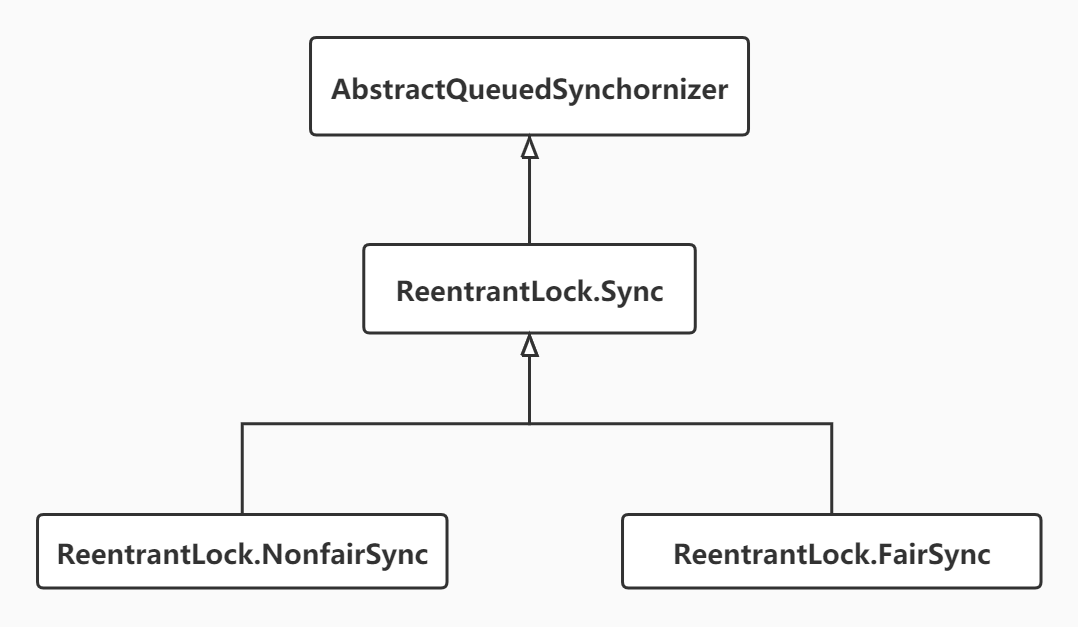AQS源码阅读
- AbstractQueuedSynchronizer 是J.U.C提供的一套锁机制,AQS将每一条请求共享资源的线程封装成一个Node节点,通过CLH队列、volatile修饰的state变量来实现锁的分配。
- AQS定义了两种资源共享方式,以不同方式共享资源的锁自定义各自的同步器:
- Exclusive: 独占 -> ReentrantLock
- Share: 共享 -> Semaphore、CountDownLatch、
// jdk1.8 AbstractQueuedSynchronizer.java
static final class Node {
/** Marker to indicate a node is waiting in shared mode */
static final Node SHARED = new Node();
/** Marker to indicate a node is waiting in exclusive mode */
static final Node EXCLUSIVE = null;
...
}
/**
* The synchronization state.
*/
private volatile int state;
- 对于一个请求共享资源的线程,AQS将其封装成一个AQS中的静态内部类Node对象,存进CLH队列的队尾。
/**
* Creates and enqueues node for current thread and given mode.
*
* @param mode Node.EXCLUSIVE for exclusive, Node.SHARED for shared
* @return the new node
*/
private Node addWaiter(Node mode) {
// 将当前线程封装为Node对象, mode为共享或独占模式
Node node = new Node(Thread.currentThread(), mode);
// Try the fast path of enq; backup to full enq on failure
Node pred = tail;
if (pred != null) {
node.prev = pred;
// 通过CAS将node设置为队尾, 处理双向链表的指针, 返回node
if (compareAndSetTail(pred, node)) {
pred.next = node;
return node;
}
}
// 若队列为空, 执行enq(node)方法插入节点
enq(node);
return node;
}
/**
* Inserts node into queue, initializing if necessary. See picture above.
* @param node the node to insert
* @return node's predecessor
*/
private Node enq(final Node node) {
for (;;) {
Node t = tail;
// 若队列为空
if (t == null) { // Must initialize
// 新建头节点, 因为AQS中的head,tail采用了懒加载模式
if (compareAndSetHead(new Node()))
tail = head;
} else {
// 将节点从尾部插入, 设置成功后返回node
node.prev = t;
if (compareAndSetTail(t, node)) {
t.next = node;
return t;
}
}
}
}
- AQS 通过 acquire(int arg) 方法尝试抢占资源
/**
* Acquires in exclusive mode, ignoring interrupts. Implemented
* by invoking at least once {@link #tryAcquire},
* returning on success. Otherwise the thread is queued, possibly
* repeatedly blocking and unblocking, invoking {@link
* #tryAcquire} until success. This method can be used
* to implement method {@link Lock#lock}.
*
* @param arg the acquire argument. This value is conveyed to
* {@link #tryAcquire} but is otherwise uninterpreted and
* can represent anything you like.
*/
public final void acquire(int arg) {
// tryAcquire(arg)由同步器根据需要各自实现
// 获取锁失败时将当前线程封装为独占模式的Node存入CLH队列并不断竞争锁, 若此过程该线程被中断过则返回true, 否则返回false, 竞争过程不处理中断
// 如果在竞争锁过程中被中断过, 则在此中断
if (!tryAcquire(arg) &&
acquireQueued(addWaiter(Node.EXCLUSIVE), arg))
selfInterrupt();
}
ReentrantLock实现的同步器

- ReentrantLock 的共享资源模式为独占,其静态内部抽象类Sync继承于AQS,基于此的公平锁和非公平锁继承了Sync,实现了各自抢占资源的方法。
/**
* Sync object for non-fair locks
*/
static final class NonfairSync extends Sync {
private static final long serialVersionUID = 7316153563782823691L;
/**
* Performs lock. Try immediate barge, backing up to normal
* acquire on failure.
*/
final void lock() {
// 非公平锁先尝试抢占资源, 通过CAS设置state, 若成功即把当前线程设置为独占线程, 否则
if (compareAndSetState(0, 1))
setExclusiveOwnerThread(Thread.currentThread());
else
acquire(1);
}
protected final boolean tryAcquire(int acquires) {
return nonfairTryAcquire(acquires);
}
}
/**
* Performs non-fair tryLock. tryAcquire is implemented in
* subclasses, but both need nonfair try for trylock method.
*/
final boolean nonfairTryAcquire(int acquires) {
final Thread current = Thread.currentThread();
int c = getState();
// 若c(state)为0, 则当前锁没有被锁定, 获取锁并且将占有线程设置为当前线程
if (c == 0) {
if (compareAndSetState(0, acquires)) {
setExclusiveOwnerThread(current);
return true;
}
}
// state不为0但占有线程是当前线程, 说明是重入, state增加即可
else if (current == getExclusiveOwnerThread()) {
int nextc = c + acquires;
if (nextc < 0) // overflow
throw new Error("Maximum lock count exceeded");
setState(nextc);
return true;
}
// 竞争锁失败返回false
return false;
}
/**
* Sync object for fair locks
*/
static final class FairSync extends Sync {
private static final long serialVersionUID = -3000897897090466540L;
final void lock() {
acquire(1);
}
/**
* Fair version of tryAcquire. Don't grant access unless
* recursive call or no waiters or is first.
*/
protected final boolean tryAcquire(int acquires) {
final Thread current = Thread.currentThread();
int c = getState();
// 当前锁没被占有, 尝试
if (c == 0) {
// 判断是否有前面的节点在抢占锁
// 没有则可以尝试抢占锁(公平)
if (!hasQueuedPredecessors() &&
compareAndSetState(0, acquires)) {
setExclusiveOwnerThread(current);
return true;
}
}
// 占有锁线程是当前线程, 重入
else if (current == getExclusiveOwnerThread()) {
int nextc = c + acquires;
if (nextc < 0)
throw new Error("Maximum lock count exceeded");
setState(nextc);
return true;
}
return false;
}
}